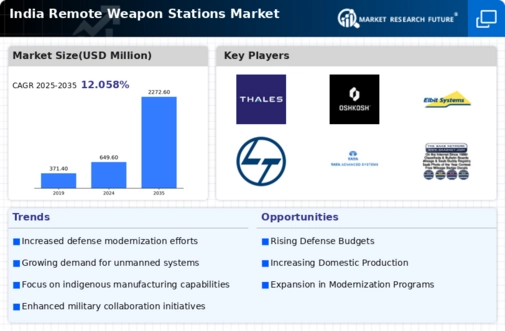Rising Security Concerns
The market is experiencing growth due to escalating security concerns in India. The increasing frequency of cross-border tensions and internal security threats has prompted the Indian government to enhance its defense capabilities. This has led to a strategic focus on advanced weapon systems, including remote weapon stations, which provide enhanced operational efficiency and safety for personnel. The Indian defense budget has allocated approximately $70 billion for modernization efforts, with a significant portion directed towards acquiring advanced technologies. This trend indicates a robust demand for remote weapon-stations, as they offer a tactical advantage in various combat scenarios, thereby driving the market forward.
Increased Military Collaboration
Increased military collaboration between India and other nations is emerging as a significant driver for the remote weapon-stations market. Joint exercises and defense agreements with countries such as the United States, Russia, and Israel have facilitated technology transfer and knowledge sharing. These collaborations often involve the integration of advanced weapon systems, including remote weapon stations, into the Indian military framework. As India seeks to enhance its defense capabilities through international partnerships, the demand for sophisticated remote weapon-stations is likely to rise. This trend not only strengthens India's defense posture but also fosters innovation within the domestic defense sector.
Technological Integration in Defense
The integration of cutting-edge technologies into defense systems is a key driver for the remote weapon-stations market. Innovations such as artificial intelligence, machine learning, and advanced sensor technologies are being increasingly adopted in military applications. The Indian armed forces are actively seeking to modernize their equipment, which includes the deployment of remote weapon stations that can be integrated with unmanned systems and surveillance technologies. This technological convergence not only enhances operational capabilities but also reduces the risk to personnel. As a result, the market is likely to witness a surge in demand for sophisticated remote weapon-stations that can leverage these advancements.
Focus on Counter-Terrorism Operations
The focus on counter-terrorism operations is a critical driver for the remote weapon-stations market in India. With the persistent threat of terrorism, the Indian armed forces are increasingly adopting advanced weapon systems that can be deployed in urban and rural environments. Remote weapon stations provide the necessary firepower while minimizing risks to personnel during operations. The Indian government has allocated substantial resources towards counter-terrorism initiatives, which include the procurement of advanced military technologies. This strategic emphasis on counter-terrorism is expected to propel the demand for remote weapon-stations, as they play a vital role in enhancing operational effectiveness in such missions.
Government Initiatives for Defense Modernization
The Indian government's initiatives aimed at defense modernization are significantly influencing the remote weapon-stations market. Programs such as 'Make in India' and 'Atmanirbhar Bharat' are designed to promote indigenous manufacturing and reduce dependency on foreign defense imports. This policy shift encourages domestic companies to develop and produce advanced military technologies, including remote weapon stations. The government has set a target to achieve a defense manufacturing turnover of $25 billion by 2025, which is expected to bolster the local defense industry. Consequently, this creates a favorable environment for the growth of the remote weapon-stations market as local manufacturers ramp up production capabilities.






















Leave a Comment